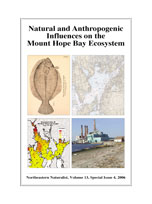Stephen B. Barrett, Brian C. Graves, Barbara Blumeris
Northeastern Naturalist 13 (sp4), 31-46, (1 December 2006) https://doi.org/10.1656/1092-6194(2006)13[31:TMHBTR]2.0.CO;2
For nearly a decade, Massachusetts resource managers have been systematically inventorying, assessing and restoring coastal wetlands degraded by infrastructure crossings such as bridges and culverts, which, unless properly designed and constructed, restrict tidal flow to upstream areas. These crossings—known as tidal restrictions—alter the natural flooding and flushing dynamics of coastal estuarine and wetland habitats, causing damage to salt marshes, eelgrass beds, and other important shellfish and finfish habitats. The Mount Hope Bay Tidal Restriction Atlas, undertaken by the Massachusetts Wetlands Restoration Program and the US Army Corps of Engineers, is the most recent addition to the statewide inventory effort.
The Atlas lists a total of 74 potential tidal restrictions that were initially identified on maps and aerial photographs, of which 25 sites were documented using rapid field assessment techniques. Each field-visited site was assessed for severity of restriction and habitat impacts, potential environmental benefits of restoration, and logistical feasibility for implementing restoration. Using these factors, sites were prioritized using a high/medium/low scale. A three-page Site Assessment Report, which includes data, maps, and photographs, was generated for each field-visited site. The final Atlas was presented in an interactive digital format to allow users to query its database and readily move between data fields, maps, and photographs. The Atlas was distributed to stakeholders as a tool for use in restoration planning and implementation.

